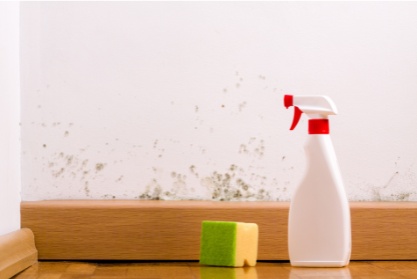
Cleaning mold can be done with some simple household items and a bit of elbow grease. Here’s a step-by-step guide on how to clean mold effectively:
Step 1: Gather your supplies
- Protective gear – gloves, mask, googles
- Plastic sheets/tarps
- Warm soapy water in a bucket
- Sponge/scrubbing brush/cloth
- Water, white vinegar or hydrogen peroxide
- Towel/cloth
Step 2: Safety first
- Before you start, make sure to wear protective gear such as gloves, a mask, and goggles to prevent any allergic reactions or inhalation of mold spores.
Step 3: Ventilate the area
- Open windows and doors to allow fresh air to circulate while you’re cleaning. This helps to prevent the spread of mold spores to other areas of your home.
Step 4: Contain the affected area
- Use plastic sheets or tarps to cover nearby furniture or items to prevent them from getting moldy during the cleaning process.
Step 5: Scrub the moldy surface
- Mix a solution of warm water and mild detergent (such as dish soap) in a bucket. Dip a sponge, scrub brush, or cloth into the solution and vigorously scrub the moldy surface. This will help to remove the mold from the surface.
Step 6: Use a mold-killing solution
- For tougher mold stains or persistent mold growth, you can use a solution of equal parts water and white vinegar or hydrogen peroxide. Spray or apply the solution to the moldy area and let it sit for a few minutes before scrubbing again.
Step 7: Rinse the area
- Once you’ve scrubbed away the mold, rinse the area with clean water to remove any remaining cleaning solution and mold residue.
Step 8: Dry the area thoroughly
- Use a clean towel or cloth to dry the cleaned area completely. Mold thrives in damp environments, so it’s essential to make sure the area is thoroughly dried to prevent mold from returning.
Step 9: Dispose of cleaning materials
- After you’ve finished cleaning, dispose of any sponges, brushes, or cloths that came into contact with the mold to prevent spreading spores to other areas of your home.
Step 10: Prevent future mold growth
- To prevent mold from returning, keep the area clean and dry, fix any leaks or water damage promptly, and use a dehumidifier in areas prone to high humidity.
If you’re dealing with extensive mold growth or are unsure about how to handle the situation safely, it’s best to consult with a professional mold remediation specialist.
